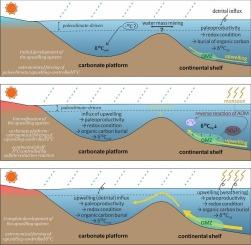Controls on carbon isotopes during the upwelling system development in shallow marine environments: Regional evolution in the Roadian (Mid-Permian) of South China
IF 2.7
2区 地球科学
Q2 GEOGRAPHY, PHYSICAL
Palaeogeography, Palaeoclimatology, Palaeoecology
Pub Date : 2025-08-19
DOI:10.1016/j.palaeo.2025.113215
引用次数: 0
Abstract
Throughout geological time, upwelling systems have been widespread in shallow marine environments. However, the regional carbon cycle in shallow marine environments during the development of upwelling systems remains unclear. During the middle Permian, astronomically forced upwelling systems were widespread along the west coast of Pangaea and the paleoequator. This study focuses on the astronomical-forced middle Permian (Roadian) rhythmites from the South China continental shelf and carbonate platform to explore the evolution of carbon isotope control factors in shallow marine environments during upwelling system development. Based on geochemical characteristics, time series analyses, and wavelet coherence analyses, the Roadian stage was subdivided into three phases in upwelling system evolution. As the system developed, the continental shelf became oxygen-depleted, warm–humid, and highly weathered, whereas the carbonate platform remained relatively stable. First, the initial development stage. The δ13Corg on the continental shelf and the δ13Ccarb in the carbonate platform averaged −25.67 ± 0.57 ‰ and 3.61 ± 0.25 ‰, respectively. Carbon isotopes in shallow marine environments were primarily controlled by paleoclimate fluctuations (and the upwelling effect). The relatively cool–dry climate weakened continental weathering, upwelling, and organic carbon burial on the continental shelf. However, these conditions also lowered sea levels and restricted water exchange in the carbonate platform, leading to 12C depletion. Next, with the intensification of upwelling, its influence on intra-platform carbon isotopes surpassed paleoclimates, with δ13Ccarb remaining stable at 3.86 ± 0.39 ‰. The influx of upwelling during sea-level rise promoted organic carbon burial and a positive shift in δ13Ccarb. On the continental shelf, nevertheless, δ13Corg values decreased slightly to −25.98 ± 0.61 ‰. The rapid expansion of the oxygen minimum zone reduced sulfate concentrations, facilitating reverse reactions of the anaerobic oxidation of methane and thereby highlighting the control of sulfate reduction reactions on δ13C. Simultaneously, TS and Fepy contents declined, along with siderite and pyrite deposition. Finally, during the complete development stage, the δ13Ccarb values in the carbonate platform stabilized at 3.77 ± 0.45 ‰, while the δ13Corg declined to −26.93 ± 0.39 ‰. The upwelling intensity and redox conditions gained dominance over δ13C by promoting organic carbon burial in shallow marine environments.

浅海环境上升流系统发育过程中碳同位素的控制:华南中二叠统鲁甸统区域演化
在整个地质时代,上升流系统在浅海环境中广泛存在。然而,浅海环境在上升流系统发展过程中的区域碳循环尚不清楚。在二叠纪中期,天文强迫上升流系统在泛大陆西海岸和古赤道广泛存在。本文以华南陆架和碳酸盐岩台地的天文强迫中二叠世(路迭世)节律岩为研究对象,探讨上升流系统发育过程中浅海环境中碳同位素控制因素的演化。基于地球化学特征、时间序列分析和小波相干性分析,将罗迪亚期演化过程划分为3个阶段。随着该系统的发展,大陆架变得缺氧、温暖潮湿、高度风化,而碳酸盐台地则保持相对稳定。一是初始发展阶段。陆架δ13Corg平均值为- 25.67±0.57‰,台地δ13Ccarb平均值为3.61±0.25‰。浅海环境碳同位素主要受古气候波动(及上升流效应)的控制。相对凉爽干燥的气候减弱了大陆风化、上升流和大陆架有机碳埋藏。然而,这些条件也降低了海平面,限制了碳酸盐台地的水交换,导致12C枯竭。其次,随着上升流的增强,其对台内碳同位素的影响超过了古气候,δ13Ccarb稳定在3.86±0.39‰。海平面上升期间上升流的涌入促进了有机碳埋藏和δ13Ccarb的正偏移。而在大陆架上,δ13Corg值略有下降,为- 25.98±0.61‰。氧最小带的迅速扩大降低了硫酸盐浓度,促进了甲烷厌氧氧化的逆反应,从而突出了硫酸盐还原反应对δ13C的控制。同时,TS和Fepy含量下降,菱铁矿和黄铁矿沉积。在完整发育阶段,碳酸盐岩台地δ13Ccarb稳定在3.77±0.45‰,δ13Corg下降到−26.93±0.39‰。在浅海环境中,上升流强度和氧化还原条件对δ13C起主导作用,促进了有机碳埋藏。
本文章由计算机程序翻译,如有差异,请以英文原文为准。
求助全文
约1分钟内获得全文
求助全文
来源期刊
CiteScore
5.90
自引率
10.00%
发文量
398
审稿时长
3.8 months
期刊介绍:
Palaeogeography, Palaeoclimatology, Palaeoecology is an international medium for the publication of high quality and multidisciplinary, original studies and comprehensive reviews in the field of palaeo-environmental geology. The journal aims at bringing together data with global implications from research in the many different disciplines involved in palaeo-environmental investigations.
By cutting across the boundaries of established sciences, it provides an interdisciplinary forum where issues of general interest can be discussed.

 求助内容:
求助内容: 应助结果提醒方式:
应助结果提醒方式:


